Young Grower Award Nominations
Each year, GrowerTalks gives out the Young Grower Award, which is a wonderful honor for individuals under the age of 35. The nomination form is out and ready for you to complete, but hurry, as the deadline is March 1. I bet you know of a deserving whippersnapper to nominate and there's no better way to show them how much you appreciate them and their importance to the future of our industry! The award is sponsored by Dümmen Orange and AmericanHort.
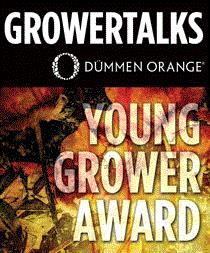
Winners will get a free trip to Columbus to attend Cultivate'18, and a fancy dinner with Anna Ball and other industry notables. Again, we're taking nominations until March 1. So do it. Now!
Be Sure to Look Below (Remix)
I absolutely stole that tag line from Paul Pilon over at Perennial Pulse and his piece inspired this article. This is the time of year that landscape contractors in the south are ramping up activities and receiving plant shipments, and in a flash our northern contingent will follow suit.
It always amazes me at that so few contractors inspect plants for landscape jobs when receiving them. Obviously, we see what’s above the soil line, but the real question is what lies beneath? When I lived in Sweden, it was common practice for contractors to spot-check the rootballs of containerized plants to be installed in landscapes. In North America, not so much.
I wondered why, so I called about a dozen contractor friends who had quite a few excuses that ranged from “I don’t have time” to “It may be perceived as rude.” One of the 12 actually spot-checked rootballs.
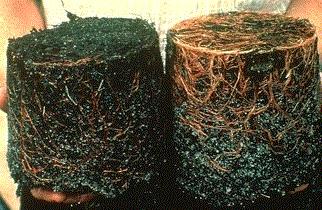
These two rootballs were from gardenias growing side-by-side in a commercial nursery with identical canopies (same size, healthy foliage and in flower). Of course, the one on the left is infected with Phytophthora root rot and the one on the right is not.
But why should you consider doing so? Because rootballs are the window to the soul of a containerized plant. Five seconds and you can determine if the plant is hopelessly pot-bound, not fully rooted out, has an obvious root-disease, etc. While it may cause some headaches to reject a shipment, your client will be much happier in the end. And a happy client means a happy contractor—and more business!

Green Antelopehorn Milkweed
Since I stole Paul Pilon’s thunder above, I figured I would milk it (pun intended) by promoting a perennial milkweed that I love. I must admit, however, that I didn't know this plant until recently when my effervescent graduate student (Mary Lewis) introduced me to it.
Asclepias viridis is a common pastureland species from Kansas to Texas and differs from many of its milkweed relatives because it's a shorty, especially for a milkweed, coming in at 12- to 24-in. tall. Flowers emerge on stem terminals, with mature plants having as many as a dozen stems. The result is quite a show in mid-summer. And the flowers are very interesting, having a cream to greenish appearance with purple hoods in the center of each floret. Cold hardiness will depend upon the seed source, but as a general rule it's hardy from Zones 5 to 9.
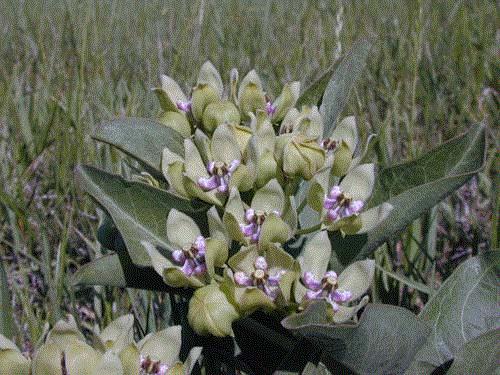
You’re not going to find any cultivars of this plant, which isn’t a bad thing, and few folks carry the plant, which baffles me. Most are seed-grown and flower in the second year and thereafter. Seed stratification is easily accomplished by wrapping seed in moist stratification, putting it in a Ziploc bag, and throwing it in the refrigerator for 45 days.
Do you grow this marvelous species? If so, I’d love to hear about your experience with it: mchappell@ballpublishing.com.

Granulate Ambrosia Beetle
While growers and landscape contractors deal with a LOT of insect pests, I’m not sure if one exists that causes more heartburn than granulate ambrosia beetle (Xylosandrus crassiusculus). Why? Well first, it has a remarkably broad woody host range. Second, its geographical footprint has grown significantly since first being detected in South Carolina in the 1970s. It's established its footprint from Missouri to Texas and east to the Atlantic, with spot infestations across the nation.
Finally, what plants it attacks are totally random from year to year, with no reasoning behind what is targeted in any given year. As a result, growers and contractors end up having to treat just about everything on the host list (which continues to be added to annually).
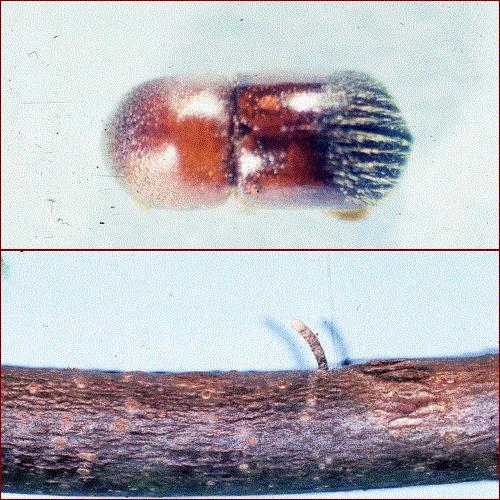
At just a few millimeters in size, these little buggers can do some serious damage. The bottom image shows the telltale "toothpick," which is frass (poop) mixed with sawdust.
Treatment isn’t easy either. Contact insecticides must be applied to the trunks of susceptible plants, which means multiple applications throughout the spring and summer. And those applications begin early in the season, with deep south locations getting under way now, especially if the weather stays this ridiculously warm across the eastern U.S. (it’s even getting warm at the Ball Publishing mothership in West Chicago).
Luckily, there are methods of detecting when granulate ambrosia beetles become active. My preferred method is using a small section of wood (4 in. in diameter and 2 ft. in length) from a susceptible host species soaked overnight in ethanol (grain alcohol, not rubbing alcohol; denatured is okay). When done soaking overnight, also drill a half-inch diameter hole down the center as far as you can (but not the entire length) and fill it with ethanol. Put a stopper of some sort (a cork, for instance) in the hole and then hang the bolt of wood about waist high at the edge of the property. The beetles will be attracted to these traps before healthy nursery/landscape plants and I suggest you use several around the property. Check the traps daily and begin a spray program as soon as you see beetle activity, known as “toothpicks.”

InstantHedges
If you attended MANTS, and during the horticultural overload period managed to stop and look at the Rare Tree Nursery booth, you may have seen the display of InstantHedges. Before I go further, let me thank the marketing folks of InstantHedges for keeping the "T" in Instant!
But back to the topic—it’s pretty ingenious, especially considering its simplicity. The concept revolves around providing what consumers want. You ask, "What is that?" Instant gratification, of course. That’s why they hire a landscape contractor in the first place!
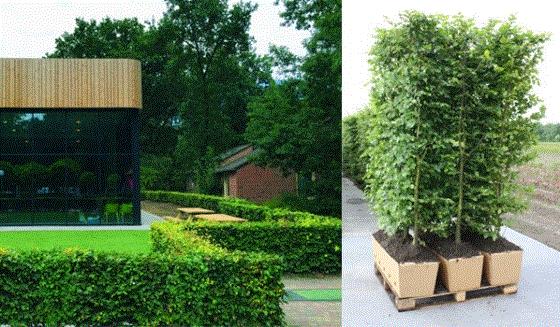
The basic idea is to have a containerized hedge that can be planted at a landscape site and have a same-day effect at planting. When I see these photos, all I can think is that this is as elegant as my beautiful wife, who takes 30 minutes to look like a movie star. Wouldn’t it be nice to have the same in a landscape, in the era of instant gratification? I think so—and I think Brent Markus and the folks at Rare Tree Nursery are onto something big here.

Here Comes the California Drought … Again
After last winter’s (2016-17) ample snowpack, a lot of contractors and growers who reside in California or ship into the state hoped that the long-standing drought would continue to ease in the coming years. Unfortunately, this winter has provided extremely little snowpack (20% of normal for the Northern Sierra Range) or beneficial rainfall, which provides a substantial amount of the water consumed by both consumers and agricultural operations in the southern half of the state. As a result, the southern half of the state has been placed back into drought status.
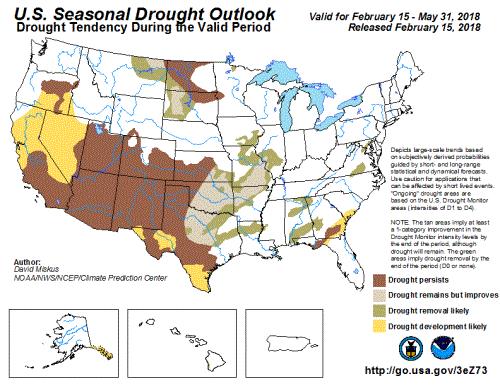
What’s more concerning is that the Central Valley Project (U.S. Bureau of Reclamation) predicts that it only expects to deliver 20% of contract supplies to agricultural producers in the region, despite many reservoirs being at historic normal levels for this time of the year. Add to that the fact that legislation has been introduced that, if adopted, could make permanent the water restrictions implemented between 2013-17 and it's not looking great for producers or consumers in 2018. And there's little relief in sight, according to the U.S. Seasonal Drought Outlook.

Cinnamon Girl Maple
I’m a huge fan of maples and especially those with multiple-season interest. Cinnamon Girl definitely checks that box and then some. Developed at Arnold Arboretum and named by Al Fordham, it’s a hybrid of Acer griseum (paperbark maple) x A. maximowiczianum (Nikko maple). Hardy from Zones 4b to 8b, the hybrid resembles paperbark maple in many respects, but is a much more vigorous grower with a mature size of 30 ft. and an oval- to vase-shaped form.
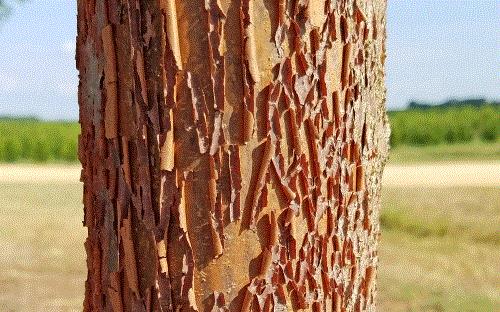
Now that's bark worth fondling!
Foliage emerges a rusty color and changes to green as leaves expand and fall color is a very dark red. The winter interest box gets checked, too, as the bark is a cinnamon color and exfoliates with age. While I haven’t seen it used as a street tree, the size and sheer toughness of its parents cause me to think it would work well in urban environments. It’s definitely a tree worth trying!
Our Wacky Wonderful World—Notes from the Edge of Sanity
This week, I got to sit in on a talk by Lloyd Traven, owner of Peace Tree Farms in Kintnersville, Pennsylvania. For those who don’t know Lloyd, he’s a forward thinker and a guy that must affix a filter with duct tape and zip ties before speaking to a group, which is why I think of him as a kindred spirit. If you ever have the pleasure to sit and listen to him, you’ll realize that he doesn’t take much stock in what we have historically done as an industry. Sure, we’ve grown plants in black “plastic” pots and planted them in a single-family home’s landscape, but horticulture is so much more than that to the people who will buy our products in the future.
Horticulture is about our clients’ emotional connection to the world that surrounds them. A connection to their ecosystem (even if it is a manufactured ecosystem) and a desire to exist among it, even in the smallest of urban spaces. Its their connection to the insects that buzz around them, the green stuff that they chew in their collective mouths and the excitement that swells in them when their children see the vivid colors of a flower.
These will be the majority of our clients, if they're not already, in the not-too-distant future. They may not be the biggest landscape contracts. They may not be the biggest buyers. But they will be what keeps our industry thriving. They’ll support the community gardens, public gardens and homeowners with the space to have awesome gardens. So don’t forget about them as we enter the spring season. And ask yourself: What can your business do to draw them into horticulture? What products can you offer to make them feel like successful contributors to the ecosystem that surrounds them?
That is going to be what saves our industry from irrelevance.


Live authentic,

Matthew Chappell
Editor-at-Large
Nursery & Landscape Insider
This has been received by 29,718 of the hardest-working horticulturists in show business!
If you're interested in reaching 29,718 (and growing) clients who eagerly await every Nursery & Landscape Insider and surely read every word, contact Kim Brown ASAP and she'll hook you up. And spread the word... let's get to 30,000 readers!